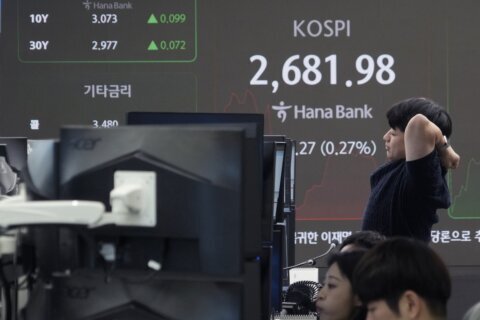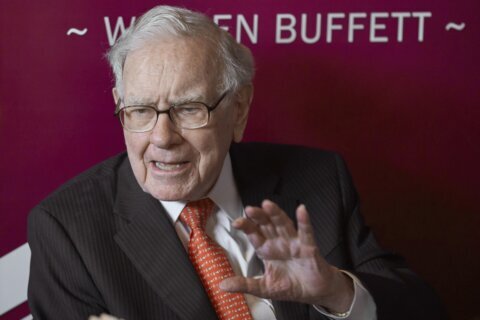NEW YORK (AP) — When Jennifer Kent’s “The Babadook” opened in theaters a decade ago, it played at two cinemas. When it returns to theaters next month, it will be in 500.
“It’s strange but in a wonderful way. I can’t quite believe it’s been 10 years already. But it’s fantastic to go back and be a part of it,” Kent says, speaking from Australia. “Considering that it only released on such a small number of screens, I feel proud that it’s still enduring.”
“The Babadook,” a chilling parable of parenthood that ushered in a new era of daring, cinematic horror films, is just one of many movies making an anniversary run in theaters this year. Look at almost any movie theater marquee right now and you’ll probably see not just new titles but a smattering of older films, too.
At a time when nearly everything is available at home with a few clicks, nothing is surging on the big screen as much as yesterday’s movies. Repertory cinema, once the home of the arthouse, is now in the multiplex, too.
And sometimes, the ticket sales can be eye-popping. In the last two weeks, the beloved 2009 stop-motion Laika Studios film “Coraline,” by Henry Selick, has grossed more than $25 million — a staggering sum for a 15-year-old movie. Earlier this year, Disney’s re-release of “Star Wars: Episode One – The Phantom Menace” made $19.4 million globally.
This fall will see anniversary releases of “Shaun of the Dead,” “Paris, Texas,” “Whiplash,” “Hoop Dreams,” “Interstellar” and many more. It’s not uncommon, of course, for restored classics to return to theaters. ( “Seven Samurai” and “The Conversation” are among those that have this summer.) But it’s a new feature of moviegoing that fairly recent movies are seeing wide re-releases – and that audiences are packing theaters for them.
“The Babadook,” a small independent film propelled to cult status by widespread raves — even William Friedkin hailed it as an instant classic — will very possibly outgross the $1 million it made a decade ago in North America.
“It has grown a new fan base,” says Nicole Weis, vice president of distribution for IFC. “The majority of the fans didn’t see it theatrically. This strategy of bringing it back was so people could see a film they’ve fallen in love with as they should, as it was intended to be, on the big screen.”
Theatrical hasn’t returned to pre-pandemic levels. But that’s partly due to theaters not having enough movies to show. The number of films released nationwide in theaters has lowered for various reasons. The year’s movie calendar was significantly altered by last year’s prolonged work stoppages.
Partly to help fill such voids, the nation’s three largest theater chains – AMC, Regal and Cinemark — in 2005 formed Fathom Events. It distributes, among other things, live broadcasts of the Metropolitan Opera and special events like the annual Studio Ghibli Fest, which brings back classics from the Japanese anime studio. Its release of “Coraline,” including 3-D screenings, set a new high mark for Fathom.
“The interest in classic movies has really gone up,” Ray Nutt, chief executive of Fathom says. “This year we’ll see a 75% increase year over year in this category.”
When Fathom started out, they mainly looked to play films on quiet days in cinemas, like Mondays and Tuesdays. But they’ve steadily expanded. Earlier this year, one of their biggest hits was a run of the “Lord of the Rings” trilogy over Saturday-Sunday-Monday. Upcoming classics includes anniversary showings of “Rear Window,” “Blazing Saddles,” “Mean Girls” and “The Fifth Element.”
“We joke around here a lot about what is the definition of a classic movie,” says Nutt. “It used to be something like 50 years or whatever, and now we’re talking about ‘Coraline’ at 15.”
Some streaming services tend to hide older film from their home pages. But in such a digital sea of content, how new a movie can sometimes be less relevant. (“Titanic” and “The Equalizer” have both charted this summer on Netflix’s most-watched lists.) The differential between theater and home is becoming less about what’s new and more about the viewing experience. Do you want to see “Jaws” on your couch while flipping through your phone, or on a big screen with an audience collectively on the edge of their seats?
Mark Anastasio, the program director of the Coolidge Corner Theatre, a six-screen non-profit cinema in Brookline, Massachusetts, was struck by the appeal older films had when the Coolidge was reopening from pandemic closure. At the time, there were paltry first-run films to play.
“But the interest in the repertory never went away,” says Anastasio. “We’ve got six screens here. It used to be that once or twice a week we’d run an older film at 7 p.m. And we’ve now increased our repertory offerings so that we’re showing an older movie every single night of the week, including Saturday and Sunday nights. And the demand is there.”
Now, Anastasio is finding he can program increasingly creatively, reaching deeper into filmmaker catalogues — and the crowds keep turning up. This week he had a packed house for Spike Lee’s “Inside Man” in 35mm, the other day Friedkin’s 1977 thriller “Sorcerer” was a success. The Coolidge’s upcoming plans include three weeks of 70mm screenings (“Lawrence of Arabia,” “Inception”) and a “Schlock and Awe” series of William Castle films, complete with their original gimmicks, like seats that buzz during “The Tingler.”
Such programming isn’t new for urban arthouses but it’s expanding. Increasingly, older films are being shown on screens usually reserved for first-run movies. Some of that is out of necessity.
“There’s about 20-30% less films being majorly distributed now than there were just five years ago,” says Jeremy Boviard, the general manager of the four-screen Moviehouse in Millerton, New York. “There’s definitely more holes in certain programming weekends.”
Boviard has had to be more selective about what appeals to Hudson Valley moviegoers, but some choices really click. Last year, that included the 40th anniversary of Jonathan Demme’s Talking Heads concert film “Stop Making Sense.” It was released by A24, which prides itself on cutting-edge contemporary films but has begun experimenting with re-releases. “Stop Making Sense” made more than $5 million domestically.
The trend isn’t likely to slow down any time soon. Studios now regularly comb through their archives and patiently await notable anniversaries. For Kent, it’s a positive development in what she otherwise calls “a dark age for cinema.”
“I feel like people still crave that experience,” says Kent. “I went to see on the weekend Dryer’s ‘Ordet’ and Bergman’s ‘The Seventh Seal.’ Especially in ‘Ordet,’ it’s such a transcendent film. The audience, we were collectively experiencing it. I could hear people crying at the end. It’s the reason that we went to the cinema in the first place — to have an experience. Not to sit on our couch while we’re looking at our phones watching some sort of content. It’s not bringing out the best in us or in the work.
“For me,” she adds, “I take it very seriously, because I think we need it.”
Copyright © 2024 The Associated Press. All rights reserved. This material may not be published, broadcast, written or redistributed.






